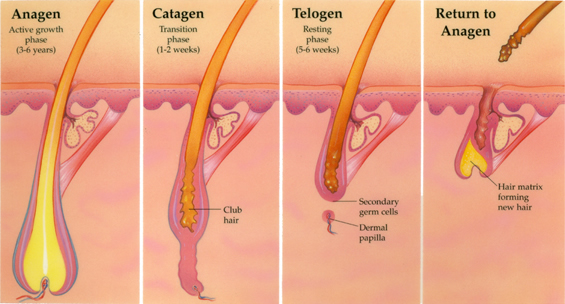 Hair loss is a very common condition that affects most people at some time in their lives. Everyone loses hair. It is normal to lose about 50-100 hairs every day. If you notice bald patches or lots of thinning, you may be experiencing hair loss.
Hair loss is a very common condition that affects most people at some time in their lives. Everyone loses hair. It is normal to lose about 50-100 hairs every day. If you notice bald patches or lots of thinning, you may be experiencing hair loss.
There are many causes to hair loss, including thyroid disease, anemia, protein deficiency, and low vitamin levels.
Androgenetic alopecia is a common form of hair loss in both men and women. In men, this condition is also known as male-pattern baldness. Hair is lost in a well-defined pattern, beginning above both temples. Over time, the hairline recedes to form a characteristic “M” shape. Hair also thins at the crown (near the top of the head), often progressing to partial or complete baldness.
Often times, baldness is blamed on poor circulation to the scalp, vitamin deficiencies, dandruff, and even excessive hat-wearing. All of these theories have been disproved. It’s also untrue that hair loss can be determined by looking at your maternal grandfather, or that 40-year-old men who haven’t lost their hair will never lose it.
Primarily caused by a combination of: Aging, change in hormones, family history of baldness, burns or trauma, in which case hair replacement surgery is considered a reconstructive treatment, and hair loss and restoration be covered by health insurance.
Hair Replacement Surgery Candidates
Hair replacement candidates must have healthy hair growth at the back and sides of the head to serve as donor areas.
Donor areas are the places on the head from which grafts and flaps are taken.
Other factors, such as hair color, texture and waviness or curliness may also affect the cosmetic result.
There are a number of techniques used in hair replacement surgery. Sometimes, two or more techniques are used to achieve the best results.
Hair replacement surgery can enhance your appearance and your self-confidence, but the results won’t necessarily match your ideal. Before you decide to have surgery, think carefully about your expectations and discuss them with your surgeon.
It’s important to understand that all hair replacement techniques use your existing hair. The goal of surgery is to find the most efficient uses for existing hair.
Hair transplantation techniques, such as punch grafts, mini-grafts, micro-grafts, slit grafts and strip grafts are generally performed on patients who desire a more modest change in hair fullness. Flaps, tissue-expansion and scalp-reduction are procedures that are usually more appropriate for patients who desire a more dramatic change.
Remember, there are limits to what can be accomplished. An individual with very little hair might not be advised to undergo hair replacement surgery.
UNDERSTANDING HAIR LOSS

How Hair Grows
The portion of the hair that we can see is called the shaft. Each shaft of hair protrudes from its follicle, which is a tube-like pouch just below the surface of the skin. The hair is attached to the base of the follicle by the hair root, which is where the hair actually grows and where it is nourished by blood capillaries. Like the rest of the body, hairs are made of cells. As new cells form at its root, the hair is gradually pushed further and further out of the follicle. The cells at the base of each hair are close to the blood capillaries, and are living.
As they get pushed further away from the base of the follicle they no longer have any nourishment, and so they die. As they die, they are transformed into a hard protein called keratin. So, each hair we see above the skin is dead protein. It is the follicle, which lies deep in the skin, that is essential in growing hair. Also, the thickness of each hair depends on the size of the follicle from which it is growing.
Hair Growth Has Several Stages
ANAGEN PHASE
The first phase is the growing stage. Hair grows at about 1 cm each month, and this phase can last between 2 and 5 years.
CATAGEN PHASE
As this phase begins the bulb detaches from the blood supply and the hair shaft is pushed up.
THE TELOGEN PHASE
This is followed by a resting stage, during which there is no growth. This phase lasts about 5 months. At the end of the resting phase, the hair is shed, and the follicle starts to grow a new one. At any moment, about 90% of the hair follicles of the scalp are growing hairs in the first phase; only about 10% are in the resting phase. If a follicle is destroyed for any reason, no new hair will grow from it.
How Baldness Occurs
If any of the stages of hair growth are disrupted, the individual may become bald. For example, if follicles shut down (meaning that they stay in the resting phase, and then shed the hair) instead of growing new hairs, there will be less hair on the head. Another reason might be interference with the formation of new hair cells at the root during the growing phase. If follicles have been destroyed (i.e., a burn, loss of layered skin or trauma), there will be baldness in that area. An individual can also look bald if the hairs are growing but are so fragile that they break just as they emerge from the follicle.
Psychology of Hair Loss, Prevention and Re-growth
Hair forms a vital element of an individual’s physical appearance. Changes in the hair, including its loss, can have correspondingly profound effects on interpersonal reactions and on self image. Studies that have specifically addressed the psychosocial impact of hair loss in men have shown that men with visible hair loss are perceived as older, weaker, and less physically attractive than their non-balding counterparts.
Not surprisingly, such adverse social stereotyping of individuals with hair loss has a considerable impact on the self image, and therefore on the quality of life, of balding men.
Many men are strongly motivated to seek help with their hair loss, the treatment objectives may include the prevention of further hair loss, the maintenance of existing hair, the re-growth and retention of lost hair, or any combination of the three.
Prevention
Studies show that many men are more anxious to prevent further hair loss in the future than they are to re-grow the hair they have already lost. This is an important point because secondary prevention, that is the prevention of further loss is currently a realistic treatment goal for our physicians to offer. At Estetica Hair Restoration, we offer real treatments and prevention through the drug treatments now available such as Rogaine and others.



